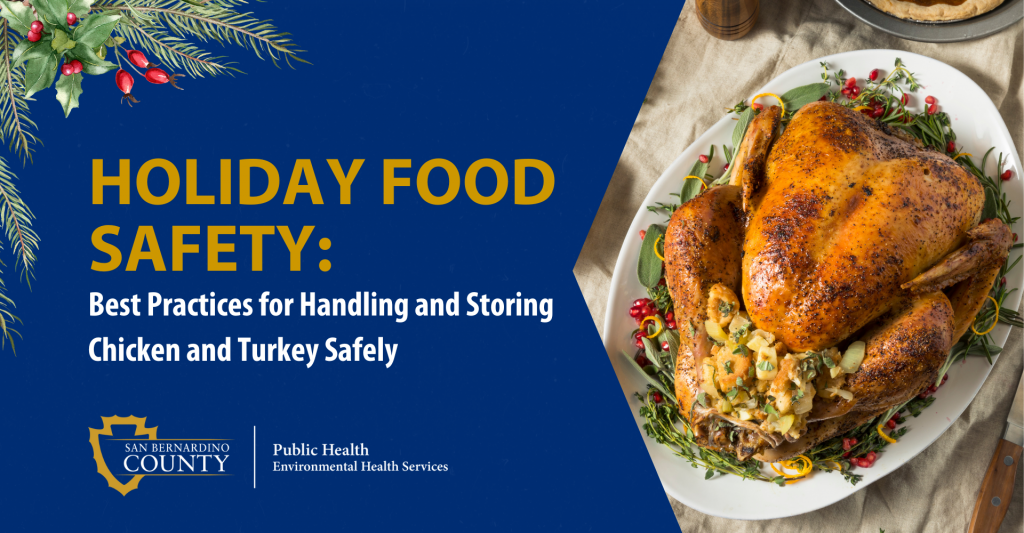

This Thanksgiving, prioritize the health and safety of your loved ones by following these best practices for holiday food safety. By taking simple yet crucial steps in the kitchen, you can enjoy a delicious feast without compromising the well-being of your family and friends. Remember, a safe Thanksgiving is a happy Thanksgiving!
Here are five best practices for handling and storing chicken and turkey safely:
- Store raw poultry in the refrigerator (40ºF) 1 or 2 days only before cooking or freezing. Store whole birds in the freezer (0ºF) for up to 1 year; parts for up to 9 months; giblets for 3 to 4 months.
- Before cooking poultry, throw away the packaging and rinse the product under cool running water. Make sure to cut poultry on a nonporous cutting board.
- Wash any cutting board, utensils, and counters with detergent and hot water immediately.
- Set oven temperature no lower than 325ºF. For doneness, cook breasts to an internal temperature of 170ºF and dark meat or whole birds to 180ºF, or until juices run clear and the flesh is tender.
- Refrigerate leftovers within 2 hours after cooking.
Let’s address common poultry safety concerns by answering these frequently asked questions.
“Do bacteria from poultry contaminate the counter and everything they contact? Can bacteria pass from object to object or into cuts on my hands?”
Poultry, like all raw food of animal origin, carries salmonella and other bacteria. It should be handled carefully to prevent cross contamination. Never let raw poultry or its juices contact cooked food or food that will be eaten raw, such as salad ingredients.
Salmonella bacteria must be eaten to cause illness. They cannot enter the body through a cut on your hand. Refrigeration slows the growth of salmonella and thorough cooking destroys it.
“After I left the grocery, I did more shopping. The turkey roast was in my van for 3 hours on a 90° day. Is it safe?”
Absolutely not. Do not leave poultry in a hot car for more than 30 minutes. The supermarket should be your last stop before heading home. Perishable food, like turkey, should be the last you choose before checkout. Unload perishables from your car first and refrigerate them immediately.
“Sometimes when I buy chicken, it looks frozen but by the time I get it home, it is defrosted. Is it safe to freeze?”
Yes. What you have observed is only frozen surface tissues. The entire chicken is not frozen. Processors quickly chill and store fresh chicken at 28º to 32ºF to prevent the rapid growth of bacteria and increase its shelf-life.
“I’ve had a thawed turkey breast in the refrigerator 8 days. Is it safe to cook? I’m 90 and I don’t want to get sick.”
Senior citizens, pregnant women, very young children and people who suffer from chronic illnesses are especially vulnerable to foodborne bacteria.
For persons of any age, 8 days is too long to refrigerate raw or cooked poultry. The safe time limit for refrigerating raw poultry is 1-2 days; 3-4 days if it is cooked.
Your turkey may have begun to spoil. Even without spoilage, indicators like an off-odor or sticky surface, harmful bacteria may be present. Discard it.
“I’m concerned about the dark color of meat around the bones of chicken. How do you prevent it?”
First, it is perfectly safe to eat chicken meat that turns dark during cooking. The darkening around bones occurs primarily in young broiler-fryers 7 to 9 weeks old. Since their bones have not calcified completely, pigment from the bone marrow can seep through the porous bones. When the chicken is cooked, the pigment turns dark. Try buying a more mature 5 – 7 pound baking hen or debone chicken.
For more information regarding food safety, please contact the Department of Public Health Division of Environmental Health Services at ehs.sbcounty.gov or call us at (800) 442-2283.


